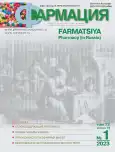Development of a methodology for the quantitative determination of essential oils using peroxic acids
- Authors: Agafonov A.M.1, Remezova I.P.2, Anosova L.S.1
-
Affiliations:
- Donetsk National Medical University named after M. Gorky
- Pyatigorsk Medical and Pharmaceutical Institute – branch of the Volgograd State Medical University of the Ministry of Health of Russia
- Issue: Vol 72, No 1 (2023)
- Pages: 15-21
- Section: Pharmaceutical chemistry and pharmacognosy
- URL: https://journals.eco-vector.com/0367-3014/article/view/313268
- DOI: https://doi.org/10.29296/25419218-2023-01-03
- ID: 313268
Cite item
Abstract
Introduction. Essential oils of plants are a variety of mixtures of compounds, most of which are terpenoids. They are characterized by the following pharmacological indicative properties: antiseptics against a wide range of bacteria and fungi (eucalyptus oil, cumin, cinnamon, clove oil); antispasmodics (mint oil); mucolytics and diuretics (turpentine oil from conifers); and also exhibit anti-inflammatory and wound healing effects. Aniseed oil stimulates the secretion of bronchial glands, ammonia promotes the release of sputum and its easy excretion. Quality control of medicines based on essential oils (anise oil) is very difficult and requires expensive equipment.
Objective: to study the kinetics of the reaction of epoxidation with trans-anethole peroxic acid and, based on the data obtained, to develop a simple method for the quantitative determination of anise oil in ammonia-anise drops and in dill water.
Material and methods. As objects for the study, ammonia-aniseed drops of factory manufacture ("LLC "Ternopharm"), extemporally prepared dill water ("LLC "Pharmacy No. 122") and the chemical substance trans-anetol were used. To quantify the main component of the essential oil, we used an epoxidation reaction using the highest aliphatic peroxic acid – peroxidecanoic acid (C10) as an oxidizer in methylene chloride at room temperature.
Results. Kinetic curves of the reaction of epoxidation of the objects of study with peroxic acid are obtained. The stoichiometry of the reaction and the optimal conditions of the epoxidation reaction (t – 40 min, 293°K) and the reaction rate in dichloromethane (kef=0.3 l/mol·min) were established, and used for the analysis of ammonia-aniseed drops and dill water.
Conclusion. Based on the data obtained, a simple method for determining essential oils using peroxic acids has been developed, which allows for quality control of medicines without the use of expensive equipment.
Full Text
About the authors
Alexey Mikhailovich Agafonov
Donetsk National Medical University named after M. Gorky
Email: chuh2008@yandex.ru
ORCID iD: 0000-0002-0682-1366
Assistant of the Department of Pharmaceutical and Medical Chemistry
Donetsk People's Republic, 16, Ilyich Ave., Donetsk, 283003Irina Petrovna Remezova
Pyatigorsk Medical and Pharmaceutical Institute – branch of the Volgograd State Medical University of the Ministry of Health of Russia
Email: i.p.remezova@pmedpharm.ru
ORCID iD: 0000-0003-3456-8553
D.Sc.Pharm., Professor of the Department of Toxicological and Analytical Chemistry
Russian Federation, 11, Kalinin Ave., Pyatigorsk, 357500Lyudmila Sergeevna Anosova
Donetsk National Medical University named after M. Gorky
Author for correspondence.
Email: apteka-NaNya@yandex.ru
ORCID iD: 0000-0002-9380-4619
Assistant of the Department of Pharmaceutical and Medical Chemistry
Donetsk People's Republic, 16, Ilyich Ave., Donetsk, 283003References
- Pashteckij V.S., Nevkrytaya N.V. The use of essential oils in medicine, aromatherapy, veterinary medicine and plant growing (review). Tavricheskij vestnik agrarnoj nauki. 2018; 1 (13): 16–32. doi: 10.25637/TVAN2018.01,02 (in Russian).
- Ponomareva E.I., Molohova E.I., Holov A.K. The use of essential oils in pharmacy. Sovremennye problemy nauki i obrazovaniya. 2015; 4. URL: https://science-education.ru/ru/article/view?id=21156 [Accessed 23.07.2022] (in Russian).
- Tihomirov A.A. Principles of using essential oils for medical purposes. Sbornik nauchnyh trudov v GNBS. 2014; 139: 116–26 (in Russian).
- Asbahani A.E. et al. Essential oils: From extraction to encapsulation. International J. of Pharmaceutics. 2015; 483: 220–43. doi: 10.1016/j.ijpharm.2014.12.069
- Frolova A.V. Essential oils are promising sources in the development of antimicrobial medicines for the local treatment of purulent wounds. Vestnik Vitebskogo gosudarstvennogo medicinskogo universiteta. 2010; 9 (1): 1–10 (in Russian).
- Ponomareva E.I., Mavrina A.R., Votinceva E.O., Molohova E.I. Essential oils on the pharmaceutical market. Teoreticheskie i prikladnye aspekty sovremennoj nauki. 2014; 6–2: 116–20 (in Russian).
- Gosudarstvennyj reestr lekarstvennyh sredstv RF. Available at https://grls.rosminzdrav.ru/Default.aspx [Accessed 23.07.2022] (in Russian).
- FS.3.4.0005.18 Ammonia-anise drops solution for oral alcohol. The State Pharmacopoeia оf The Russian Federation, XIV-ed. T. 4. M., 2018 (in Russian).
- Saxena S.N., Kakani R.K., Rathore S.S., Meena R.S., Vishal M.K., Sharma L.K., Agrawal D., John S., Panwar A., Singh B. Genetic Variation in Essential Oil Constituents of Fennel (Foeniculum vulgare Mill) Germplasm. J. Essent. Oil Bear. Plants. 2016; 19 (4): 989–99. doi: 10.1080/0972060X.2016.1191378
- OFS.1.5.2.0001.15 Essential oils. The State Pharmacopoeia оf The Russian Federation, XIV-ed. T. 2. M., 2018 (in Russian).
- Seguru N.V., Rudakova I.L., Vandyshev V.V., Samylina I.A. Methods of quality control of essential oils. Pharmacy. 2005; 3: 3–5 (in Russian).
- Molchan N.V., Rudakova I.P., Samylina I.A. Determination of essential oil in medicinal plant raw materials. Farmacija. 2009; 5: 3–4 (in Russian).
- Trineeva O.V., Slivkin A.I., Safonova E.F. Determination of Nettle Leaves Extracts Antioxidant Activity by Various Methods. Drug development & registration. 2020; 9 (3): 59–66. doi: 10.33380/2305-2066-2020-9-3-59-66 (in Russian).
- Guidelines for the preparation and quality control of peppermint and dill water from 10.07.89y, VO Soyuzfarmaciya (in Russian).
- Parker W.E. Ricciuti C., Ogg C.L., Swern D. Peroxides II. Preparation, Characterization and Polarographic Behavior of Longchain Aliphatic Peracids. J. Amer. Chem. Soc. 1955; 77: 4037–41.
- Organikum. Per. s nem. M.: Himiya, 1992; 2: 363–5 (in Russian).
- OFS.1.1,0022.18 Mernaya posuda. The State Pharmacopoeia оf The Russian Federation, XIV-ed. T. 1. M., 2018 (in Russian).
- Chulanovskij VM. Infrared absorption spectra of polymers and excipients. Himiya. 1969; 356 (in Russian).
- GOST 3902-82 Fennel essential oil. Technical conditions (in Russian).
Supplementary files








